FIELD VETERINARY REPORT FOR MAASAI MARA - FEBRUARY 2018 By Dr
FIELD VETERINARY REPORT FOR MAASAI MARA - FEBRUARY 2018
By Dr. Campaign Limo
Introduction
The month was relatively quiet with few cases reported. With stringent measures undertaken by Park Management, all illegal activities such as grazing have ceased and the wildlife is thriving. Though there has been reduced precipitation, there is still enough forage and water for the wildlife within and around the park.
The following cases were handled during the period:
CASE#1 INJURED ELEPHANT BULL
Date: 1st Feb 2018
Species: African elephant
Sex: Male
Age: Adult
Location: Siana-Nkineji
History
This big bull was reported to be in poor condition by Olarro Conservancy and KWS rangers based in Nkineji. He was reported to be alone and wasting away in a small thicket near a lugga. The Vet Unit found him in the lugga but he retreated deep into the thicket on approach. Helicopter services became necessary to push this bull out of the lugga and thicket for further examination and treatment.
Immobilization, examination and treatment
With initial resistance, this bull was finally pushed out into the open using a helicopter and darted with 15mgs Etorphine hydrochloride through a 1.5ml Dan-inject dart from the air. Induction time was ten minutes and he went down initially on sternal recumbency before being pushed to lie on his left lateral side.


Examination revealed a severely wasted bull with poor body score. There was a penetrating wound to the right temporal side that exited on the right side with sepsis. There was another deep penetrating wound to his forehead which appeared to have been caused by a projectile. This elephant was in severe pain with grave prognosis. Euthanasia was considered but he succumbed whilst the team was still deliberating.
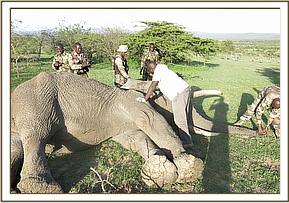

Conclusion
This elephant with big tusks was most likely targeted for poaching and sustained suspected gunshot wounds to the head leading to debilitating injuries.
KWS and Olarro conservancy rangers removed the tusks for safe custody and accounting.
CASE#2 SNARED ZEBRA
Date: 5th Feb 2018
Species: Common zebra
Age: Adult
Sex: Male
Location: Olarro Motorogi Conservancy
History
This snared zebra was seen and reported to us by Olare Motorogi conservancy rangers. He was found isolated from the other zebras with two wires snares, one on the left rear limb at the fetlock joint and another around the neck. Both were plain wire snares.
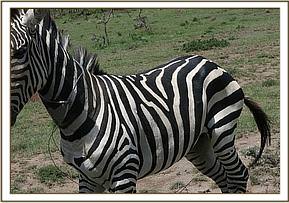

Immobilization, examination and treatment
Restraint was achieved chemically by use of a combination of 6mgs Etorphine hydrochloride and 50mgs Azaperone delivered through a 1.5ml Dan-Inject dart. The zebra was darted from a vehicle, after which it ran for a few minutes before being overwhelmed by the drugs and assumed sternal recumbency. He was made to lie in an appropriate position for de-snaring.
The snare on the left leg had slightly eaten into tissues while the one on the neck was loose. Both snares were removed with resultant wounds being debrided and disinfected with tincture of Iodine. He received Amoxicillin antibiotics 4500mgs, parenterally to stop advancement of sepsis. Additionally, he was given 1000mgs Flunixin meglumine anti-inflammatory intramuscularly before being reversed.
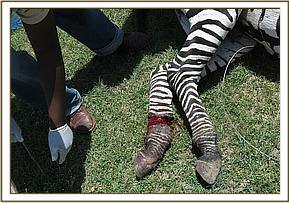

Reversal
Reversal of the anaesthetic was achieved by intravenous administration of 18mgs Diprenorphine hydrochloride through the jugular vein. He woke up two minutes after reversal and joined the rest of the herd.
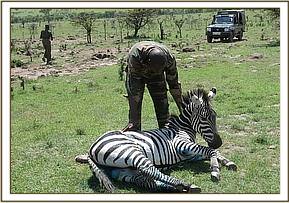

Prognosis
Good.
CASE#3 INJURED ELEPHANT BULL
Date: 7th Feb 2018
Species: African elephant
Age: Adult
Sex: Male
Location: Masai Mara National Reserve
History
This big bull was seen injured by Naibor lodge guides together with the Masai Mara Reserve rangers on the morning of this date. They called the Vet Unit for help. This bull was found browsing alone in a small thicket with the upper portion of his rear right limb injured and swollen. He walked with difficulty.

Immobilization, examination and treatment
Restraint was achieved by use of 16mgs Etorphine hydrochloride delivered through a 3ml Dan-Inject dart from a vehicle. It took ten minutes for the drugs to take full effect with the elephant assuming left lateral recumbency.
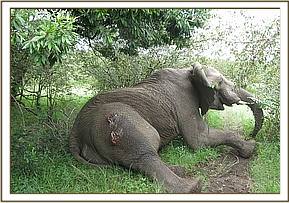

Examination revealed injuries inflicted to his right thigh extending to the right rump most likely caused by an attack from another bull. The wound margins were rough and appeared to be caused by tusks. The wounds were debrided thoroughly with Hydrogen peroxide, then rinsed with clean water and disinfected with tincture of Iodine. Green clay was then packed into the wound to facilitate healing. Other treatments involved parenteral administration of 30000mgs Amoxicillin antibiotic and 5000mgs Flunixin meglumine anti-inflammatory.
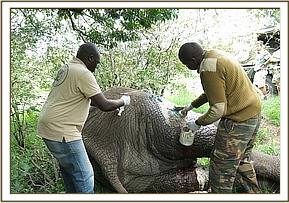

Reversal
Reversal of the anaesthetic was achieved by intravenous administration of 36mgs Diprenorphine hydrochloride through a prominent ear vein. He woke up in four minutes and retreated to the thicket.
Prognosis
Good.
CASE#4 SPEARED GIRAFFE
Date: 12th Feb 2018
Species: Masai giraffe
Sex: Male
Age: Adult
Location: Olkurruk area
History
This young male was seen with a spear lodged on the left side of his neck by Mara Triangle Conservancy Rangers and The Ann K. Taylor De-Snaring Team who alerted the Vet Unit. The two teams also participated in the treatment exercise.
Immobilization, examination and treatment
Immobilization was achieved by use of a combination of 12mgs Etorphine hydrochloride and 50mgs Azaperone. It took eight minutes for the drugs to take full effect upon which he was roped and pulled down. The anaesthetic was then reversed with 30mgs Diprenorphine hydrochloride given through the jugular vein before commencement of treatment.
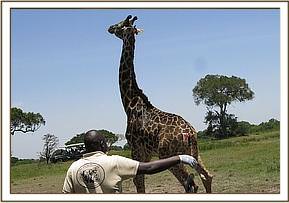

The spear was carefully removed and wound examination revealing moderate infection. It was debrided and flushed with Hydrogen peroxide and copious amount of water before being disinfected with tincture of iodine.
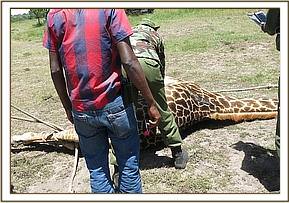

Cloxacillin ointment was infused and topical spray of Oxytetracycline then applied. Other treatments include parenteral administration of long acting Amoxicillin antibiotic and Flunixin meglumine anti-inflammatory. He was released after treatment and woke up comfortably to join the rest of the herd.
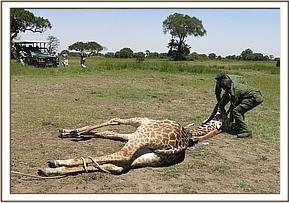

Prognosis
Good
CASE#5 INJURED LION
Date: 15th Feb 2018
Species: African lion
Age: Adult
Sex: Male
Location: Rhino ridge
History
This old male christened ‘Lipstick’ was seen injured by the Mara Reserve rangers on their normal patrol. They called the vet unit for help. Lipstick found alone, hungry and severely limping on both his right front and right hind legs.
Immobilization, examination and treatment
Immobilization was achieved by use of a combination of 4.8mgs Medetomidine and 240mgs Ketamine hydrochloride delivered through a 3ml Dan-Inject dart. Darting was carried out from a vehicle and it took eight minutes for the drugs to take full effect.
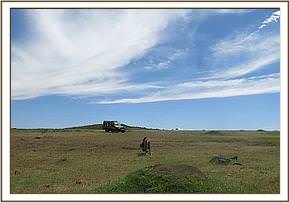

After positioning him well, examination revealed a sprain of his right shoulder with moderate swelling. His right hind leg was wasted from a long term injury with some degree of muscular atrophy. No fresh injury to this hind leg was evident.
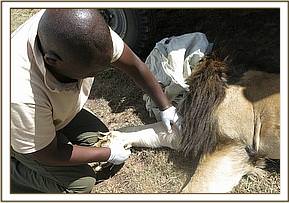

This lion is over 15 years old with his upper canines worn out and infected. There was also advanced degradation of the incisors meaning this lion cannot live without other pride members to help him kill prey. Treatment involved administration of anti-inflammatories to relieve pain and reduce swelling as well as antibiotics to prevent any opportunistic infections.
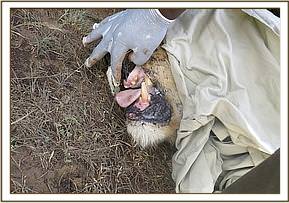

Reversal
Reversal of the anaesthetic was achieved after one hour by use of Yohimbine given intravenously through saphenous vein. He woke up in four minutes and went to a shade.
Prognosis
Due to his old age and worn out canines, this lion is approaching his sunset years in the wild and might not live for long. The good thing is that the pride was still close by and they are still hunting for him, for now.
CASE#6 EXAMINATION OF A DEAD LIONESS
Date: 17th April 2018
Species: African lion
Sex: Female
Age: Adult
Location: Kichwa Tembo (Mara Triangle)
History
This lioness was seen the morning of this date with severe lethargy and fast breathing by Mara Triangle Conservancy Rangers. It had some bite wounds that could be seen from a distance. However she died soon after the report was made to the Mobile Veterinary Unit.
Post-mortem Examination
A post-mortem conducted on arrival showed this lioness was involved in a fight with other lions and had deep injuries to her left inguinal area and left thorax. Other bite wounds were observed on her forehead. The wounds were relatively fresh though deep.
Of particular interest was the injury to her left thorax which had fractured the last two ribs and damaged the pleural cavity. The lungs were damaged, collapsed and haemorrhagic. The immediate cause of death for this lioness could have been pneumothorax causing respiratory arrest and dyspnoea.
CASE#7 REPEAT TREATMENT OF AN INJURED ELEPHANT
Date: 24th Feb 2018
Species: African elephant
Sex: Male
Age: Sub adult
Location: Olarro conservancy
History
This elephant, in a herd of several other elephants, was seen limping by the Olarro Conservancy Management. He had been treated late last year for multiple spear injuries, one deep wound to his right rump accessing the hip joint and another one to the right elbow joint. He immediately disappeared from the Conservancy for some months after improving .They called the unit for assessment. The Vet Unit found him browsing alone in a thicket away from the rest of the herd. His body condition was good except for the limp of his right fore leg. A decision to immobilise him for further examination was arrived at.
Immobilization, examination and treatment
Immobilization was achieved by use of 12mgs Etorphine hydrochloride delivered through a 1.5mls Dan- Inject dart. As he was in a thick he was darted from foot and it took ten minutes for the drugs to take full effect with this young bull assuming left lateral recumbency. After stabilizing him an examination was conducted. The wound to the rump was almost healed and the joint had recovered. Further cleaning and medication of this wound was done which did not appear to bother this bull as he was not limping from the hind quarters.
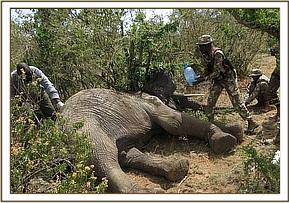

The wound to the right elbow had completely healed although the joint appeared slightly swollen. Aspiration yielded blood. It appeared there was damage to the joint with stiffness developing and this affected the gait of this elephant. Given that he was in good body condition, the damage to the joint was considered permanent and it is hoped this elephant will live positively with the problem. He was given antibiotics and anti-inflammatories parenterally before being reversed.
Reversal
Reversal was achieved by administration of 36mgs Diprenorphine hydrochloride delivered through one of the prominent ear veins. He woke up in three minutes and retreated deeper into the thicket.
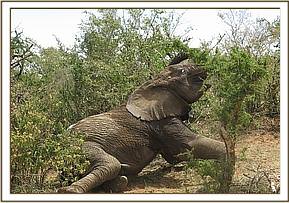

Prognosis
Prognosis is good as though he has a problem with his gait and a permanent limp, his health is good.
Other Activities
Examination of the seven lion cubs treated for mange infestation during December showed they are doing well with alopecia disappearing and they are on their way to recovery. They were seen near Olkiombo air strip doing well.
Conclusion
The Mara Mobile Unit would like to thank all stakeholders who have assisted in reporting and handling various cases requiring intervention. Thanks to Minara Foundation through DSWT for their continuous facilitation. Thanks too to KWS for their technical support.































